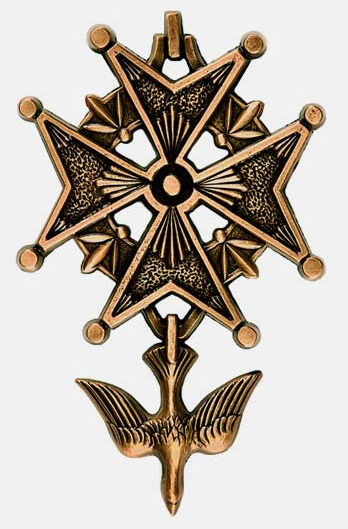The Huguenot Cross is not the cross the Huguenots of old bore, but rather the cross the Huguenots wore as an emblem of their faith. It has become the sign between Huguenots the world over. It is the golden link between the Huguenots of today and the Huguenots of France, the tie between us and our forefathers and foremothers.
The insignia used by the Huguenot Society of Maryland is the Cross of Languedoc, which consists of an open four-petalled lily of France, the petals of which form a Maltese cross. The four petals signify the four Gospels. Each arm or petal displays to rounded points at the periphery. These points are regarded as signifying the eight Beatitudes. The four petals are joined together by four fleurs-des-lys, each of which bears a rounded point distally. The twelve rounded points appearing in the four petals and four fleurs-de-lys are regarded as signifying the twelve Apostles. Beneath each fleur-de-lys, and between the arms of the two petals to which each is joined, an open space takes on the shape of a heart. Suspended from the lower central petal by a ring of gold is a pendant dove, signifying the Church under the Cross.
the petals of which form a Maltese cross. The four petals signify the four Gospels. Each arm or petal displays to rounded points at the periphery. These points are regarded as signifying the eight Beatitudes. The four petals are joined together by four fleurs-des-lys, each of which bears a rounded point distally. The twelve rounded points appearing in the four petals and four fleurs-de-lys are regarded as signifying the twelve Apostles. Beneath each fleur-de-lys, and between the arms of the two petals to which each is joined, an open space takes on the shape of a heart. Suspended from the lower central petal by a ring of gold is a pendant dove, signifying the Church under the Cross.
Historically, four different types of cross stand out prominently among the many crosses used by the descendants of the old Huguenot families. All differ from one another in detail, but conform to a general design. These precious and symbolic tokens of their faith have been secretly cherished and reverently handed down from one generation to the next. They possess a symbolism, and hallowed association, which make them objects of veneration almost too sacred to touch.
The Cross of Queryras
The Cross of Queryras, which is found in the French Alps, is the oldest form known, and was used long before the Revocation of the Edict of Nantes. The heart formed by the arms of the cross and the fleurs-des-lys is too evident to be ignored, and at once suggests the seal of the great French Reformer, John Calvin. There seems to be some doubt as to which is the older form, that with the two little balls representing tear drops – the tears of persecution – or that of the dove. This cross was adopted by the Protestant Deaconesses of France, whose prior claim was recognized by the American Huguenots.
The Cross of Languedoc
The Cross of Languedoc (la croix de Langue d’Oc) was discovered by the Reverend Andrew Mailhet in the province of Languedoc (more correctly Langue d’Oc, the tongue of Oc, which is Occitan) and dates from the eighteenth century. The fleurs-des-lys are very neat, and the striations are very fine and regular. The dove is arched and nicely feathered. This is the cross adapted by the American Huguenot Society because of its beauty and symbolism.
The Cross of Cevenole
The Cross of Cevenole is thought to be more modern than those mentioned above, and is the model generally reproduced.
May we each wear the cross of our ancestors with consciousness of pride and honour;
that it may help us in this day and time to stand for truth as they stood for truth in their day.

